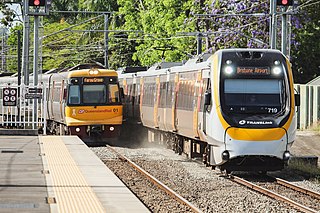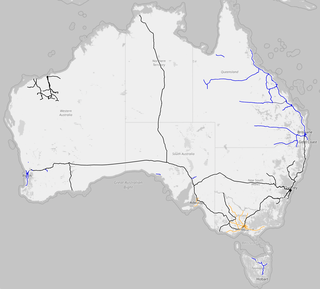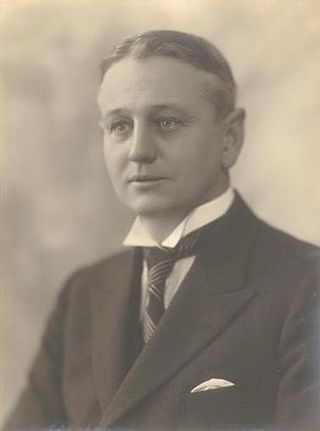Related Research Articles

There are many forms of transport in Australia. Australia is highly dependent on road transport. There are more than 300 airports with paved runways. Passenger rail transport includes widespread commuter networks in the major capital cities with more limited intercity and interstate networks. The Australian mining sector is reliant upon rail to transport its product to Australia's ports for export.

Princes Highway is a major road in Australia, extending from Sydney via Melbourne to Adelaide through the states of New South Wales, Victoria and South Australia. It has a length of 1,941 kilometres (1,206 mi) or 1,898 kilometres (1,179 mi) via the former alignments of the highway, although these routes are slower and connections to the bypassed sections of the original route are poor in many cases.

Sturt Highway is an Australian national highway in New South Wales, Victoria, and South Australia. It is an important road link for the transport of passengers and freight between Sydney and Adelaide and the regions along the route.

Rail transport in Australia is a component of the Australian transport system. It is to a large extent state-based, as each state largely has its own operations, with the interstate network being developed ever since Australia's federation in 1901. As of 2022, the Australian rail network consists of a total of 32,929 kilometres (20,461 mi) of track built to three major track gauges: 18,007 kilometres (11,189 mi) of standard gauge, 2,685 kilometres (1,668 mi) of broad gauge, and 11,914 kilometres (7,403 mi) of narrow gauge lines. Additionally, about 1,400 kilometres (870 mi) of 610 mm / 2 ft gauge lines support the sugar-cane industry. 3,488 kilometres (2,167 mi), around 11 percent of the Australian heavy railways network route-kilometres are electrified.

Cootamundra, nicknamed Coota, is a town in the South West Slopes region of New South Wales, Australia and within the Riverina. It is within the Cootamundra-Gundagai Regional Council. At the 2016 Census, Cootamundra had a population of 6,782. It is located on the Olympic Highway at the point where it crosses the Muttama Creek, between Junee and Cowra. Its railway station is on the Main Southern line, part of the Melbourne-to-Sydney line.

The Australian Rail Tram and Bus Industry Union (RTBU) is an Australian trade union representing rail, tram and bus workers. The RTBU is affiliated with the Australian Council of Trade Unions (ACTU) and the Australian Labor Party (ALP).

The Australian Services Union is a trade union representing workers in a variety of industries.

Rail gauges in Australia display significant variations, which has presented an extremely difficult problem for rail transport on the Australian continent since the 19th century. As of 2022, there are 11,914 kilometres (7,403 mi) of narrow-gauge railways, 18,007 kilometres (11,189 mi) of standard gauge railways and 2,685 kilometres (1,668 mi) of broad gauge railways. In the 19th century, each of the colonies of Australia adopted their own gauges.
Royal Melbourne Golf Club is a 36-hole golf club in Australia, located in Black Rock, Victoria, a suburb in southeastern Melbourne. Its West and East courses are respectively ranked number 1 and 6 in Australia. The West course is ranked in the top-five courses in the world. Founded 133 years ago in 1891, it is Australia's oldest extant and continually existing golf club. Unlike many metropolitan golf venues, The Royal Melbourne Golf Club has a capacity for 15,000 spectators.

The Australian Institute of Architects, officially the Royal Australian Institute of Architects, is Australia's professional body for architects. Its members use the post-nominals FRAIA (Fellow), ARAIA and RAIA. The Institute supports 14,000 members across Australia, including 550 Australian members who are based in architectural roles across 40 countries outside Australia. SONA is the national student-membership body of the Australian Institute of Architects. EmAGN represents architectural professionals within 15 years of graduation, as part of the Australian Institute of Architects.

High-speed rail in Australia has been under investigation since the early 1980s. Every federal government since this time has investigated the feasibility of constructing high-speed rail with speeds above 200 km/h, but to date nothing has ever gone beyond the detailed planning stage. Various corridors have been proposed for a potential high-speed line. The most commonly suggested route is between Australia's two largest cities, Sydney and Melbourne, which, as of 2023, is the world's sixth busiest air corridor.

Reginald John Burchell was an Australian politician. He was a member of the Australian House of Representatives for the seat of Fremantle from 1913 to 1922, initially for the Australian Labor Party and after the 1916 Labor split for the Nationalist Party.

John Lloyd (Jack) Price was an Australian politician and trade unionist. He was an Australian Labor Party member of the South Australian House of Assembly for Port Adelaide from 1915 to 1925. He later served in the Australian House of Representatives for Boothby from 1928 until his death in 1941, but left the Labor Party and joined the United Australia Party, following the 1931 Labor split over government responses to the Great Depression.
Milton Sydney Love, invariably referred to as M. S. Love, was an Australian Stipendiary Magistrate in New South Wales and the founding Warden of the Southern Mining District of NSW.

SS Persic was an ocean liner of the White Star Line, built by Harland and Wolff in 1899. She was one of the five Jubilee-class ships built specifically to service the Liverpool–Cape Town–Sydney route. The voyage took six weeks.
The National Union of Rail Workers of Australia (NUR) was an Australian trade union representing railway industry workers which operated from 1938 until 1993.
Sidney Crawford was a South Australian businessman born in Victoria.
The Building Workers' Industrial Union of Australia was an Australian trade union covering workers in the construction industry.
The Pulp and Paper Workers Federation of Australia (PPWF) was an Australian trade union which existed between 1913 and 1991. The PPWF represented workers in the pulp and paper industry.
Sir Constantine Trent Champion de Crespigny,, generally referred to as C. T. C. de Crespigny or Sir Trent de Crespigny or Trent Champion de Crespigny, was a medical doctor, clinical pathologist, academic and hospital administrator in Adelaide, South Australia.
References
- 1 2 3 4 "Federation of Salaried Officers of Railways Commissioners (1924 - 1947)". Australian Trade Union Archives. Retrieved 25 February 2018.
- 1 2 "CLAIM FOR 80-HOUR FORTNIGHT". The Advocate . Tasmania. 10 July 1948. p. 7. Retrieved 25 February 2018– via National Library of Australia.
- 1 2 "TURMOIL ON BOLTE'S RAILS". Tribune . No. 1664. Sydney. 8 July 1970. p. 10. Retrieved 25 February 2018– via National Library of Australia.
- ↑ "NEW REGISTRATIONS". The Advertiser . Adelaide. 9 February 1921. p. 11. Retrieved 25 February 2018– via National Library of Australia.
- ↑ "RAILWAY EMPLOYES CONSTITUTION". The Register . Vol. XC, no. 26, 274. Adelaide. 13 March 1925. p. 11. Retrieved 25 February 2018– via National Library of Australia.
- ↑ "THE RAILWAYS SERVICE". The Age . No. 21, 691. Victoria, Australia. 9 October 1924. p. 15. Retrieved 25 February 2018– via National Library of Australia.
- ↑ "RAILWAY OFFICERS' ORGANISATION REGISTERED". The Age . No. 21, 679. Victoria. 25 September 1924. p. 7. Retrieved 25 February 2018– via National Library of Australia.
- ↑ "RAILWAY OFFICERS". The Sun . No. 1122. New South Wales, Australia. 28 September 1924. p. 2. Retrieved 25 February 2018– via National Library of Australia.
- ↑ "RAILWAY OFFICERS' PRESIDENT". The Sydney Morning Herald . No. 27, 367. 21 September 1925. p. 12. Retrieved 25 February 2018– via National Library of Australia.
- ↑ "RAILWAY OFFICERS". The News . Vol. XI, no. 1, 677 (HOME ed.). Adelaide. 28 November 1928. p. 14. Retrieved 25 February 2018– via National Library of Australia.
- ↑ "THE RAILWAY SERVICE". The Age . No. 22, 037. Victoria, Australia. 19 November 1925. p. 9. Retrieved 25 February 2018– via National Library of Australia.
- ↑ "NO WOMEN MEMBERS". Labor Daily . No. 574. New South Wales, Australia. 23 November 1925. p. 1. Retrieved 25 February 2018– via National Library of Australia.
- ↑ "LIMITING FEMALE EMPLOY-:MENT". The Richmond River Express and Casino Kyogle Advertiser . New South Wales. 28 November 1928. p. 5. Retrieved 25 February 2018– via National Library of Australia.
- ↑ "Railway Salaried Officers' Conference". The Age . No. 23, 837. Victoria. 3 September 1931. p. 3. Retrieved 25 February 2018– via National Library of Australia.
- ↑ "Appointment and Promotion Methods Criticised". The News . Vol. XXVII, no. 4, 134. Adelaide. 21 October 1936. p. 4. Retrieved 25 February 2018– via National Library of Australia.
- ↑ "Promotion of Railway Officers". The Age . No. 25, 788. Victoria. 10 December 1937. p. 4. Retrieved 25 February 2018– via National Library of Australia.
- ↑ "SUBURBAN TRAINS MAY STOP". The Age . No. 28, 533. Victoria. 5 October 1946. p. 1. Retrieved 25 February 2018– via National Library of Australia.
- ↑ "Railway Officers May Leave A R U". The Argus . No. 31, 254. Melbourne. 31 October 1946. p. 20. Retrieved 25 February 2018– via National Library of Australia.
- ↑ "Fed. Transport Union Move". The Telegraph (SECOND ed.). Queensland, Australia. 21 March 1947. p. 3. Retrieved 25 February 2018– via National Library of Australia.
- 1 2 "T.A.A. Officers in Union Link". The Age . No. 29053. Victoria. 8 June 1948. p. 3. Retrieved 25 February 2018– via National Library of Australia.
- ↑ "TRANSPORT OFFICERS' FEDERATION". The Advocate . Tasmania. 26 August 1947. p. 5. Retrieved 25 February 2018– via National Library of Australia.
- ↑ "T.A.A. OFFICERS". The West Australian . Vol. 64, no. 19, 316. Western Australia. 12 June 1948. p. 14. Retrieved 25 February 2018– via National Library of Australia.
- ↑ "Railway strike in Vic. may spread here, if talks fail". The Sun . No. 12, 704. Sydney. 16 October 1950. p. 3 (FINAL EXTRA). Retrieved 25 February 2018– via National Library of Australia.
- ↑ "Decision reserved on union merger". The Canberra Times . Vol. 46, no. 13, 104. 21 April 1972. p. 3. Retrieved 25 February 2018– via National Library of Australia.
- ↑ "Rail workers may not collect fares". Tribune . No. 1912. Sydney. 29 July 1975. p. 2. Retrieved 25 February 2018– via National Library of Australia.
- ↑ "Industrial news Talks fail to stop NSW strike". The Canberra Times . Vol. 53, no. 15, 693. 9 September 1978. p. 3. Retrieved 25 February 2018– via National Library of Australia.
- ↑ "Ban on MP attacked". The Canberra Times . Vol. 53, no. 15, 885. 21 March 1979. p. 3. Retrieved 25 February 2018– via National Library of Australia.
- ↑ "Ban on MLA lifted". The Canberra Times . Vol. 53, no. 15, 874. 10 March 1979. p. 12. Retrieved 25 February 2018– via National Library of Australia.
- ↑ "AFAP fails to stop airlines' case going on". The Canberra Times . Vol. 64, no. 20, 230. 31 August 1990. p. 4. Retrieved 25 February 2018– via National Library of Australia.
- ↑ "IN BRIEF". The Canberra Times . Vol. 65, no. 20, 471. 30 April 1991. p. 2. Retrieved 25 February 2018– via National Library of Australia.
- ↑ "History". Australian Services Union. Retrieved 25 February 2018.